Filo pastry will be a big seller this week, being Cheesefare Week, a popular time in Greece for making pita, before Great Lent kicks off on Clean Monday next week. If you find making your own filo pastry too much work, here's a guide to buying it in Greece. The following articles were originally published through Suite101.
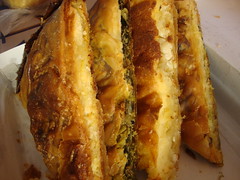 The home cook in Greece has a wide variety of filo pastry to choose from. The right kind of pastry depends on the filling and desired texture of the pie. Although I make my own filo pastry, I occassionally buy it when I want very thin sheets of pastry, which I don't have the patience to make these days.
The home cook in Greece has a wide variety of filo pastry to choose from. The right kind of pastry depends on the filling and desired texture of the pie. Although I make my own filo pastry, I occassionally buy it when I want very thin sheets of pastry, which I don't have the patience to make these days.
Most (if not all) filo pastry sold in Western countries is of the thin filmy type, nearly always sold frozen, resembling the texture and weight of cigarette paper, and it's quite fragile. In Greece, however, when applied to pastry, the term 'filo' (cf. φυλλο = leaf) denotes a wide range of pastry types, all of which have their own special purpose. The universally well known thin filo pastry is labelled 'kroustas' (κρουστας = crusty), and it is the one usually used in making baklava and galaktoboureko, the traditional Greek custard pie, along with a wide range of other sweet and savoury pies. It can be bought freshly made from a specialist store that makes it on a daily basis; or from the refrigerated goods counter at a supermarket, packaged as fresh; or from the freezer section, where it is bought frozen (once thawed, it cannot be refrozen). Most filo pastry is sold in standard 500g packets containing 12-16 30x40cm or 40x40cm sheets.
You can get an idea of what these pastries look like and are used for from a well-known Greek pastry-maker's website. Traditional food meets culinary art: spanakopita and tiropita are transformed into impressive sculpted masterpieces, giving them a new lease of life.
In Greece, spanakopita (spinach pie) and tiropita (cheese pie) are very popular street-food snacks, often sold in bakeries, snack shops and cafes. Spanakopita has also passed into the realm of global cuisine, and is now a popular pie all over the world. Both spanakopita and tiropita are made with filo pastry filled with a mixture of spinach and other leafy greens and/or a variety of cheeses. Both are considered vegetarian, while spanakopita can also be vegan, ie made without the addition of dairy products, making it a good choice for Clean Monday and the Greek Orthodox Lenten season, the fasting period before Easter.
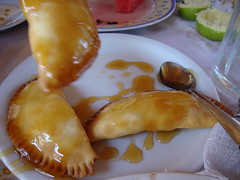 What makes these savoury pies and pastries unique is the range of shapes they come in. Filo pastry parcels, both big and small, are a form of culinary art in Greece, in similar ways that sushi is in Japan. Using the same filo pastry and pie fillings, a wide range of small and large pastries can be made, all of different shapes and sizes. Some shapes are specifically regional and they each have their own special name, while many are recognized throughout the country.
What makes these savoury pies and pastries unique is the range of shapes they come in. Filo pastry parcels, both big and small, are a form of culinary art in Greece, in similar ways that sushi is in Japan. Using the same filo pastry and pie fillings, a wide range of small and large pastries can be made, all of different shapes and sizes. Some shapes are specifically regional and they each have their own special name, while many are recognized throughout the country.
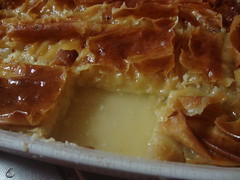 Large spanakopita and tiropita pies are cooked in a baking tin, and then cut up into triangles (if the baking vessel used is round) or squares (if it is rectangular). But the artistic flair of the cook is seen in the small individual pasties. These are preferable to large pies because they hold their shape better (especially useful when packing them for a work lunch or picnic), making the filo pastry less fragile. They also provide a form of portion control which can used in combination with weight control.
Large spanakopita and tiropita pies are cooked in a baking tin, and then cut up into triangles (if the baking vessel used is round) or squares (if it is rectangular). But the artistic flair of the cook is seen in the small individual pasties. These are preferable to large pies because they hold their shape better (especially useful when packing them for a work lunch or picnic), making the filo pastry less fragile. They also provide a form of portion control which can used in combination with weight control.
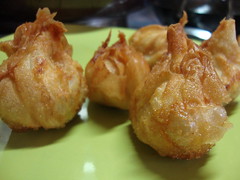 One of the most popular pita shapes often made by home cooks is the simple triangle, a seamless closed pocket made with the thin variety of filo pastry. For the home cooks who make their own phyllo dough, which is often thicker than store-bought filo pastry, the shapes are endless. In the cuisine of the island of Crete, the most common shape is the half-moon called kalitsounia, while in Central and Northern Greece, spiral savoury pies are more common. Once filo pastry is cooked, it sets, making open pasties a possibility, such as the Cretan Easter specialties of lichnarakia and baked kalitsounia. Filo pastry can also be rolled into cigar-like rolls, similar to Asian-style spring rolls, making this shape perfect as an appetizer or cocktail snack.
One of the most popular pita shapes often made by home cooks is the simple triangle, a seamless closed pocket made with the thin variety of filo pastry. For the home cooks who make their own phyllo dough, which is often thicker than store-bought filo pastry, the shapes are endless. In the cuisine of the island of Crete, the most common shape is the half-moon called kalitsounia, while in Central and Northern Greece, spiral savoury pies are more common. Once filo pastry is cooked, it sets, making open pasties a possibility, such as the Cretan Easter specialties of lichnarakia and baked kalitsounia. Filo pastry can also be rolled into cigar-like rolls, similar to Asian-style spring rolls, making this shape perfect as an appetizer or cocktail snack.
©All Rights Reserved/Organically cooked. No part of this blog may be reproduced and/or copied by any means without prior consent from Maria Verivaki.
 The home cook in Greece has a wide variety of filo pastry to choose from. The right kind of pastry depends on the filling and desired texture of the pie. Although I make my own filo pastry, I occassionally buy it when I want very thin sheets of pastry, which I don't have the patience to make these days.
The home cook in Greece has a wide variety of filo pastry to choose from. The right kind of pastry depends on the filling and desired texture of the pie. Although I make my own filo pastry, I occassionally buy it when I want very thin sheets of pastry, which I don't have the patience to make these days. Most (if not all) filo pastry sold in Western countries is of the thin filmy type, nearly always sold frozen, resembling the texture and weight of cigarette paper, and it's quite fragile. In Greece, however, when applied to pastry, the term 'filo' (cf. φυλλο = leaf) denotes a wide range of pastry types, all of which have their own special purpose. The universally well known thin filo pastry is labelled 'kroustas' (κρουστας = crusty), and it is the one usually used in making baklava and galaktoboureko, the traditional Greek custard pie, along with a wide range of other sweet and savoury pies. It can be bought freshly made from a specialist store that makes it on a daily basis; or from the refrigerated goods counter at a supermarket, packaged as fresh; or from the freezer section, where it is bought frozen (once thawed, it cannot be refrozen). Most filo pastry is sold in standard 500g packets containing 12-16 30x40cm or 40x40cm sheets.
You can get an idea of what these pastries look like and are used for from a well-known Greek pastry-maker's website. Traditional food meets culinary art: spanakopita and tiropita are transformed into impressive sculpted masterpieces, giving them a new lease of life.
In Greece, spanakopita (spinach pie) and tiropita (cheese pie) are very popular street-food snacks, often sold in bakeries, snack shops and cafes. Spanakopita has also passed into the realm of global cuisine, and is now a popular pie all over the world. Both spanakopita and tiropita are made with filo pastry filled with a mixture of spinach and other leafy greens and/or a variety of cheeses. Both are considered vegetarian, while spanakopita can also be vegan, ie made without the addition of dairy products, making it a good choice for Clean Monday and the Greek Orthodox Lenten season, the fasting period before Easter.
 |
Filo pastry and pie fillings
 What makes these savoury pies and pastries unique is the range of shapes they come in. Filo pastry parcels, both big and small, are a form of culinary art in Greece, in similar ways that sushi is in Japan. Using the same filo pastry and pie fillings, a wide range of small and large pastries can be made, all of different shapes and sizes. Some shapes are specifically regional and they each have their own special name, while many are recognized throughout the country.
What makes these savoury pies and pastries unique is the range of shapes they come in. Filo pastry parcels, both big and small, are a form of culinary art in Greece, in similar ways that sushi is in Japan. Using the same filo pastry and pie fillings, a wide range of small and large pastries can be made, all of different shapes and sizes. Some shapes are specifically regional and they each have their own special name, while many are recognized throughout the country.Portion control
 Large spanakopita and tiropita pies are cooked in a baking tin, and then cut up into triangles (if the baking vessel used is round) or squares (if it is rectangular). But the artistic flair of the cook is seen in the small individual pasties. These are preferable to large pies because they hold their shape better (especially useful when packing them for a work lunch or picnic), making the filo pastry less fragile. They also provide a form of portion control which can used in combination with weight control.
Large spanakopita and tiropita pies are cooked in a baking tin, and then cut up into triangles (if the baking vessel used is round) or squares (if it is rectangular). But the artistic flair of the cook is seen in the small individual pasties. These are preferable to large pies because they hold their shape better (especially useful when packing them for a work lunch or picnic), making the filo pastry less fragile. They also provide a form of portion control which can used in combination with weight control. One of the most popular pita shapes often made by home cooks is the simple triangle, a seamless closed pocket made with the thin variety of filo pastry. For the home cooks who make their own phyllo dough, which is often thicker than store-bought filo pastry, the shapes are endless. In the cuisine of the island of Crete, the most common shape is the half-moon called kalitsounia, while in Central and Northern Greece, spiral savoury pies are more common. Once filo pastry is cooked, it sets, making open pasties a possibility, such as the Cretan Easter specialties of lichnarakia and baked kalitsounia. Filo pastry can also be rolled into cigar-like rolls, similar to Asian-style spring rolls, making this shape perfect as an appetizer or cocktail snack.
One of the most popular pita shapes often made by home cooks is the simple triangle, a seamless closed pocket made with the thin variety of filo pastry. For the home cooks who make their own phyllo dough, which is often thicker than store-bought filo pastry, the shapes are endless. In the cuisine of the island of Crete, the most common shape is the half-moon called kalitsounia, while in Central and Northern Greece, spiral savoury pies are more common. Once filo pastry is cooked, it sets, making open pasties a possibility, such as the Cretan Easter specialties of lichnarakia and baked kalitsounia. Filo pastry can also be rolled into cigar-like rolls, similar to Asian-style spring rolls, making this shape perfect as an appetizer or cocktail snack.©All Rights Reserved/Organically cooked. No part of this blog may be reproduced and/or copied by any means without prior consent from Maria Verivaki.

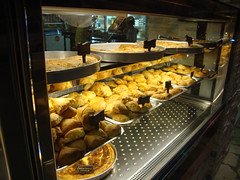
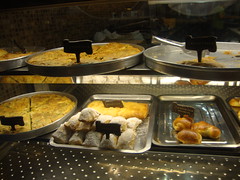
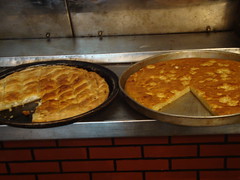
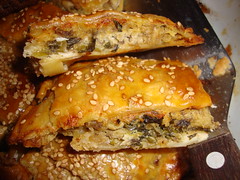
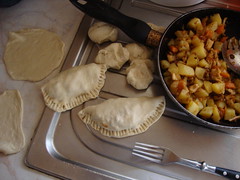
Great information about filo, I really want to try making spring rolls with filo- as you have done. I guess I wouldn't have thought of it, thanks for the great idea!
ReplyDeleteWe have some success with filo here in Canada. Sometimes it can be hit and miss whether you will get a good batch from the frozen section of your local grocers.
ReplyDeleteI love the subtle taste of the kalitsounia. Not savoury, nor sweet, the warm rich cretan mizithra inside. I vote them as my favourite, pity we don't the same mizithra outside Crete.
ReplyDelete